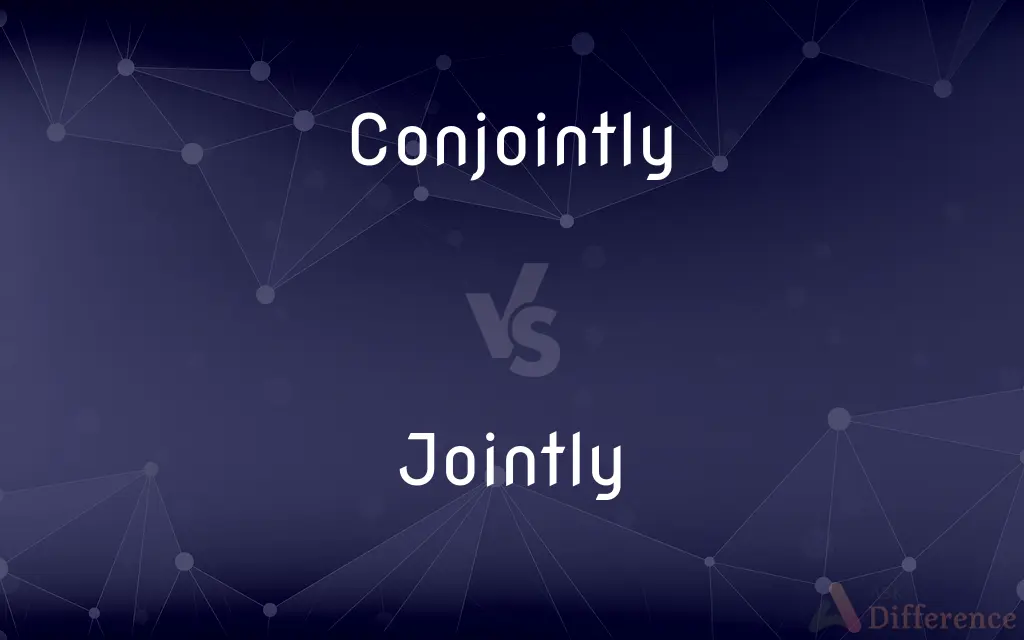Conjointly vs. Jointly — What's the Difference?
By Tayyaba Rehman & Urooj Arif — Updated on March 22, 2024
Conjointly implies united effort or action by all parties involved, focusing on unity, while jointly emphasizes collaboration or participation of two or more parties without specifying unity.

Difference Between Conjointly and Jointly
Table of Contents
ADVERTISEMENT
Key Differences
Conjointly is used to describe actions, decisions, or efforts made in close association, emphasizing the unity and collective involvement of all parties. It suggests a deeper level of cooperation or interconnection among participants, where their actions are not just parallel but interdependent. Whereas, jointly refers to two or more entities doing something together, emphasizing their collaboration or shared participation but not necessarily their interdependence or the depth of their unity.
When something is done conjointly, it often implies that all involved parties have a significant stake or role in the endeavor, and their contributions are integral to the outcome. This term is particularly relevant in contexts where unified action or decision-making is critical. On the other hand, doing something jointly can simply mean that multiple parties are involved, and while their collaboration is essential, their actions may still be somewhat independent within the overall framework of the task or project.
In legal and business contexts, conjointly can denote a scenario where parties are bound together by agreement or circumstance in a manner that requires unanimous or closely coordinated action. This contrasts with jointly, where parties may share responsibilities or rights but can act in a more segmented or individually defined capacity within the agreement or partnership.
Conjointly also carries a connotation of a more intrinsic or integrated collaboration, suggesting that the efforts or actions of the parties are not just combined but are harmoniously integrated. Jointly, while still indicating cooperation, might not carry the same depth of integration, suggesting instead a partnership where each party maintains a distinct role or contribution.
Despite these nuances, both terms underscore the importance of collaboration and shared effort. The choice between conjointly and jointly often depends on the context and the desired emphasis on the nature of the cooperation or partnership.
ADVERTISEMENT
Comparison Chart
Definition
Actions made in close association, emphasizing unity
Collaboration or participation by two or more parties
Implication
Significant stake or role by all, suggesting deep cooperation
Collaboration with possible independent actions
Legal/Business Context
Requires unanimous or closely coordinated action
Shared responsibilities with more individual capacity
Connotation
Intrinsic or integrated collaboration
Partnership with distinct contributions
Nature of Collaboration
Integrated and harmonious efforts
Cooperation with individual roles
Compare with Definitions
Conjointly
Deep cooperation.
The project was completed conjointly, showcasing the depth of their collaboration.
Jointly
Partnership.
They bought the property jointly, sharing the financial responsibility.
Conjointly
Integrated efforts.
Their research was conducted conjointly, integrating their expertise seamlessly.
Jointly
Collaboration.
They jointly authored the paper, each contributing different sections.
Conjointly
Unity.
Decisions in the partnership were made conjointly, reflecting their unified approach.
Jointly
Shared participation.
The companies jointly launched the product, pooling their resources.
Conjointly
Close association.
The team worked conjointly to develop the new protocol.
Jointly
Independent actions within cooperation.
The departments worked jointly on the project, focusing on their areas of expertise.
Conjointly
Harmonious collaboration.
The musicians performed conjointly, their sounds merging beautifully.
Jointly
Distinct contributions.
The event was organized jointly, with each organizer handling specific tasks.
Conjointly
Joined together; combined
"social order and prosperity, the conjoint aims of government" (John K. Fairbank).
Jointly
In common; together.
Conjointly
Of, consisting of, or involving two or more combined or associated entities; joint.
Jointly
Together, acting as one; collectively.
They jointly raised the child, even though they were no longer married.
Conjointly
In a conjoint manner; jointly or together
Jointly
In a joint manner; together; unitedly; in concert; not separately.
Then jointly to the ground their knees they bow.
Conjointly
In a conjoint manner; untitedly; jointly; together.
Jointly
In collaboration or cooperation;
This paper was written jointly
Conjointly
In conjunction with; combined;
Our salaries put together couldn't pay for the damage
We couldn`t pay for the damages with all out salaries put together
Jointly
In conjunction with; combined;
Our salaries put together couldn't pay for the damage
We couldn`t pay for the damages with all out salaries put together
Common Curiosities
What does conjointly mean?
Conjointly means actions or decisions made in close association, emphasizing the unity and collective involvement of all parties.
How does conjointly differ from jointly in legal terms?
Conjointly implies actions requiring unanimous or closely coordinated efforts, while jointly refers to shared responsibilities where actions can be more independent.
Can conjointly and jointly be used interchangeably?
While similar, they have nuanced differences; conjointly emphasizes deeper unity and integration, whereas jointly focuses on collaboration without specifying the depth of unity.
What does jointly mean?
Jointly refers to collaboration or participation by two or more parties, highlighting their combined efforts but not necessarily deep unity.
What is an example of a conjointly made decision?
A family deciding conjointly on buying a new home, where each member's opinion is considered integral.
Is conjointly used more in specific contexts than jointly?
Yes, conjointly is often used in contexts requiring a higher degree of integration and unanimity among participants.
Why choose conjointly over jointly?
Conjointly is chosen to highlight a more intrinsic or harmonious collaboration, whereas jointly is used for general cooperative efforts.
How do conjointly and jointly relate to collaboration?
Both terms relate to collaboration, but conjointly suggests a more harmonious and integrated effort, while jointly indicates a partnership with possibly distinct roles.
Can an action be both conjointly and jointly done?
Yes, an action can be both if it involves close collaboration and shared responsibilities, but conjointly would emphasize the unity of effort more.
Can a project be considered a success if managed conjointly?
Yes, a project can be highly successful if managed conjointly due to the deep integration and harmonious efforts of all parties involved.
How does the choice between conjointly and jointly affect legal documents?
The choice can affect the interpretation of responsibilities and actions required, with conjointly suggesting more integrated and unanimous actions.
Does jointly imply less commitment than conjointly?
Not necessarily less commitment, but jointly can imply a more segmented approach to collaboration.
How do conjointly and jointly impact business partnerships?
They can influence the perceived level of integration and cooperation among partners, affecting decision-making processes and operations.
What is an example of jointly conducted research?
Two universities jointly conducting research on climate change, each bringing unique expertise to the study.
What are the key differences in usage between conjointly and jointly?
The key differences lie in the degree of unity and integration emphasized, with conjointly focusing on more harmonious and integrated efforts, while jointly emphasizes collaboration.
Share Your Discovery

Previous Comparison
Measure vs. Record
Next Comparison
Dramatist vs. PlaywrightAuthor Spotlight
Written by
Tayyaba RehmanTayyaba Rehman is a distinguished writer, currently serving as a primary contributor to askdifference.com. As a researcher in semantics and etymology, Tayyaba's passion for the complexity of languages and their distinctions has found a perfect home on the platform. Tayyaba delves into the intricacies of language, distinguishing between commonly confused words and phrases, thereby providing clarity for readers worldwide.
Co-written by
Urooj ArifUrooj is a skilled content writer at Ask Difference, known for her exceptional ability to simplify complex topics into engaging and informative content. With a passion for research and a flair for clear, concise writing, she consistently delivers articles that resonate with our diverse audience.
















































